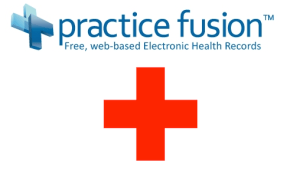I have found this article yesterday, and I am glad to say that I have been Practice Fusion Certified Consultant and Academic Partner for almost 3 years now. With a lot of skepticism from both providers and patients on the FREE software model, we have implemented it as part of our EHRS (Electronic Health Records Specialist) curricula and I am very happy we did. Having met with Ryan Howard in person, as well as key team members two years back at Practice Fusion user conference in San Francisco I was so moved and found by the whole idea of their business and the quality that they brought to the table.
Implementation of EHR systems within small and medium size practices has always been a challenge, primarily for the users. Building the workflow for the practice and making sure that your staff is computer savvy enough to navigate a system that is being implemented is very hard.
Interesting to see how in such a short period of time they were able to really build a presence for themselves in the healthcare community.
Way to go!
Practice Fusion Pulls In $34M Series C led by Artis to crush the other eMeadical Record Startups
by Josh Constine. Original article is published by Techcrunch (full body of the article is enclosed below)
Practice Fusion is the frontrunner in the fevered race to become the electronic medical record platform, and today it finished raising a $34 million Series C led by hedge fund Artis Ventures to make sure it wins and lead it towards an IPO. Practice Fusion’s valuation is now around a half a billion dollars, it tells me. Startups trying to compete? “We’re squashing them” founder and CEO Ryan Howard tells me. It now hosts 40 million patient records of its 150,000 doctor and other medical professional clients, up from 25 million records and 130,000 clients seven months ago.The money will fund a patient acquisition strategy, the build-out of its app platform, hires, and attracting more docs to ditch pen and paper for more efficient, accessible electronic records. Howard beams ”We’re excited to light it up. The company’s on fire, growth is maddening. The problem needs to be solved.”Practice Fusion develops a free, web based electronic medical record platform for physicians that lets them chart data, schedule appointments, electronically prescribe medicine, work with labs, and distribute referral letters — all things that can get in the way of actually helping the sick. It makes money by letting labs, pharmacies, and other service providers to doctors pay to advertise within the platform. There’s both a Practice Fusion desktop interface and iPad app for doctors.Howard was careful choosing Artis Ventures to lead the round, telling me “it’s a wedding. You’re married to that investor. Artis is a hedge fund with a venture fund. It’s preparing us. It’s who would be buyers in a public market” indicating the company has its sights on an IPO. Artis also backed YouTube.Practice Fusion now has a total of over $64 million in funding, and Howard admits, “We have a lot of cash on hand.” The full list of investors joining the Series C round includes long-time investors Felicis Ventures and Band of Angels, plus Glynn Capital, Ali and Hadi Partovi, Founders Fund, Morgenthaler Ventures, Scott Banister, SV Angel, Ghost Angel, and several other institutional and individual investors. Practice Fusion now ranks amongst Castlight ($160 million), and ZocDoc ($95 million) as the most heavily funded health startups.It needs it at the rate its growing. Howard tells me “we brought on about 20 people last month”. It’s got 170 employees now and expects to have 250 by year’s end. Hiring employees that quick is tough right now. “It’s more competitive than ever, especially for engineers” says Howard. But its applying its funding to becoming an attractive place to work, even compared to perked-up giants like Google and Facebook. That’s why it’s investing in a gorgeous San Francisco office, wellness programs, healthy food, and more.Howard spoke candidly about how he views Practice Fusion’s competitors like Elation EMR. “I see them getting smaller in the rear view mirror. There’s no one in the Valley that keeps me up at night.” As for the big medical companies, “Our largest competitor is Allscripts, and we took on 4x as many new users as them last quarter.” While it wouldn’t disclose exact revenue numbers, the startup told me “in Q1 2012 revenue generation was comfortably in the seven figure range, an increase of more than 500% from the same quarter in 2011.”With it pulling away from startups in the space, now it just needs to worry about huge, long-standing medical companies. Luckily it’s got a big headstart, and startup power. Howard explains “We’re making sure we can out-innovate anyone else.” And attracting the best talent to make that possible isn’t so hard thanks to its mission. “Someone could die because [a doctor] can’t get access to their chart. Understand, we’re saving lives.”
Practice Fusion provides a free, web-based Electronic Medical Record (EMR) system to physicians. With charting, scheduling, e-prescribing, billing, lab integrations, referral letters, unlimited support, Meaningful Use certification and a Personal Health Record for patients, Practice Fusion’s EMR addresses the complex needs of today’s healthcare providers and disrupts the health IT status quo. Practice Fusion is the largest and fastest growing EMR community in the country with over 160,000 users and 35 million patients. For more information on Practice Fusion,...








